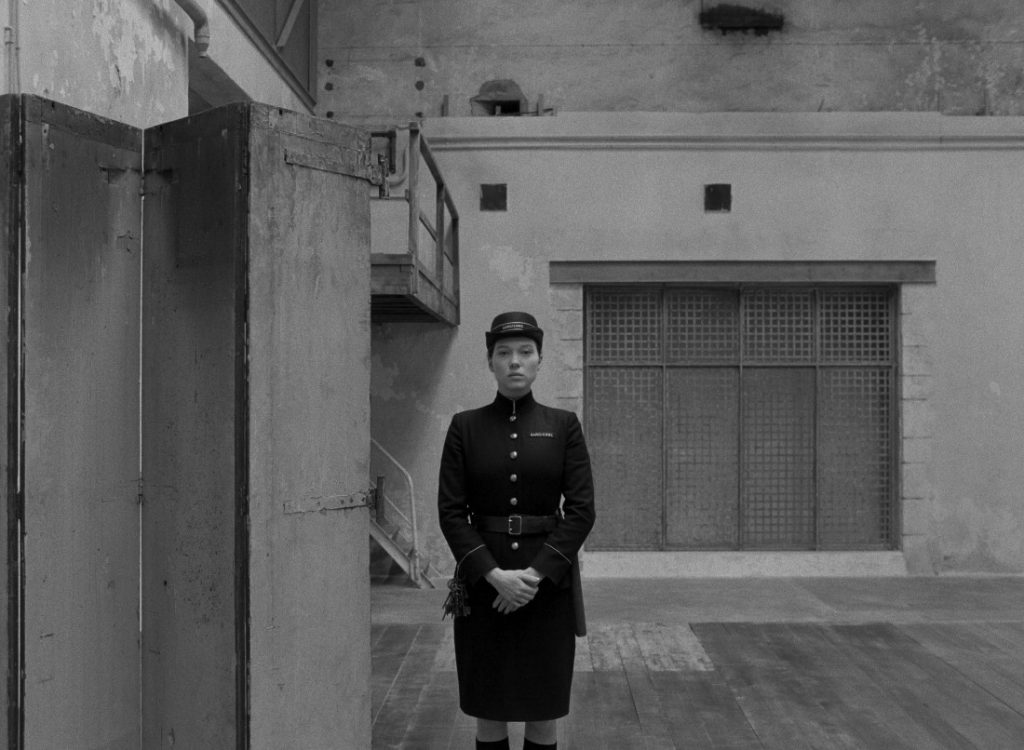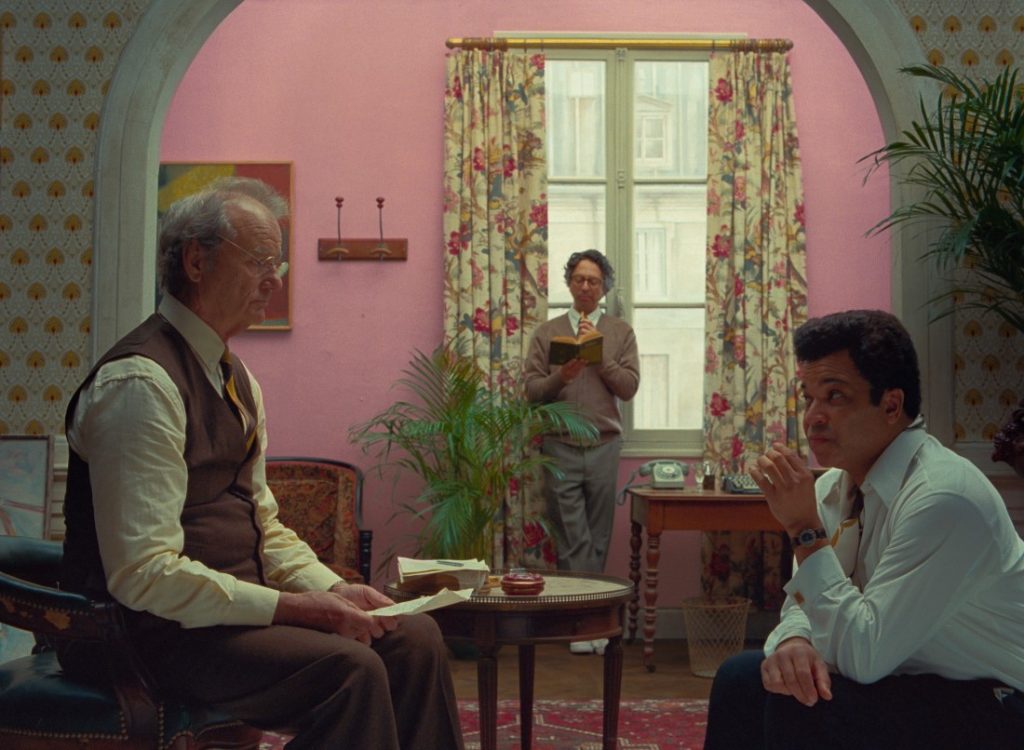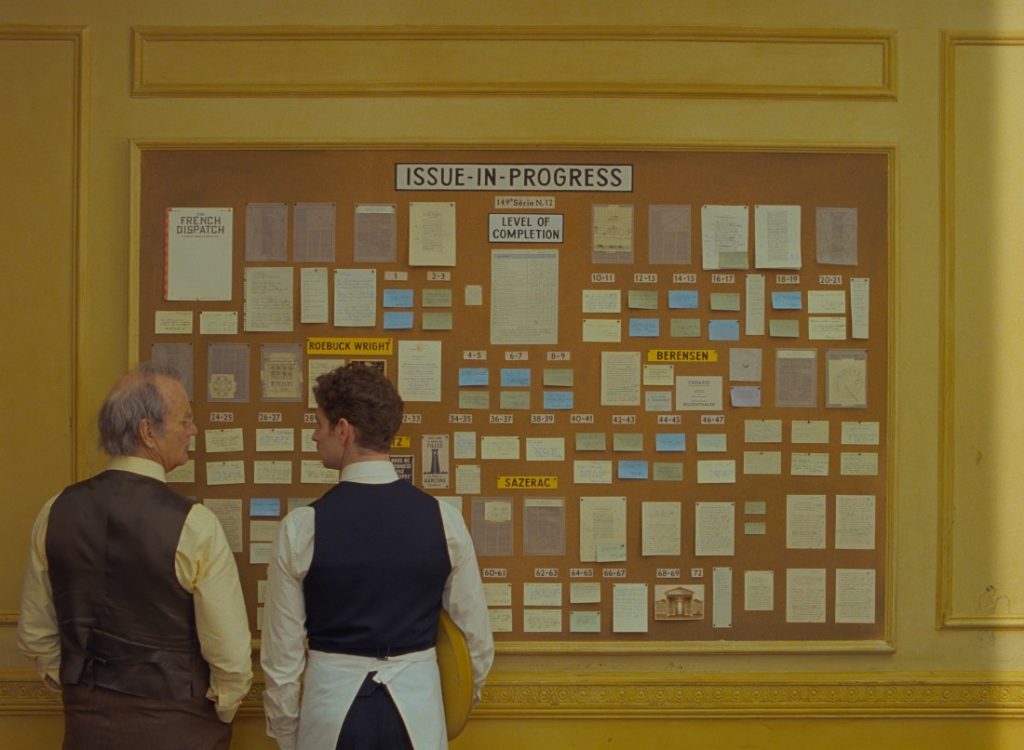
When designing The French Dispatch, production designer Adam Stockhausen and writer-director Wes Anderson pulled references from a host of different sources. They dug into photo archives and emailed each other screen grabs from films they watched.
One important reference was a 1962 Orson Welles Kafka adaptation that was recently restored in 2000.
“Looking at this Orson Welles film The Trial we were talking about how nice it was that the scenery is built inside of a train station,” Stockhausen tells MovieMaker.
Artifice is built into Anderson’s films as a feature, and it was the artifice of Welles’ satire that appealed to Anderson and Stockhausen.
“You feel the train station in the movie,” Stockhausen says. “You feel it in the background behind the scenery, it becomes part of the scenery, but is separated from it in an interesting way. And so we were looking for a location that could give us something a little bit like that.”
They found this prison space in a factory just outside Angoulême, France where The French Dispatch was lensed. The anthology film follows the editing of an issue of the American publication The French Dispatch of the Liberty, Kansas Evening Sun, published weekly in the fictional French city of Ennui-sur-Blasé. Each feature comprises a key part of this particular edition of The French Dispatch. In typical Wes Anderson fashion, a host of A-list stars round out the cast: Bill Murray, Tilda Swinton, Jeffrey Wright, Mathieu Amalric, Owen Wilson and many more.

This prison sequence stars Benicio del Toro as a murderer-artist, Léa Seydoux as a prison guard/muse, and Adrien Brody as an art dealer representing del Toro’s imprisoned painter.
Outside of filmic references and emailed screen grabs, the internet plays a key role in pre-production but Stockhausen is clear to note it as more of a jumping off point.
“The internet is a great repository of things, but then very often, the internet will give you a clue. And then that thread will have to be pulled,” he says.
His team might notice a collection of photos originate from one collection “at some little museum in some little town in Buenos Aires,” Stockhausen presents as an example. And so they’ll call and ask this little museum to scan more photos — ones not available on the web — and send them back to them.
“A lot of things start with the internet, but then they lead a lot deeper than that,” he adds.
While Welles’ The Trial was an influence on the prison, this immense collection of images Stockhausen and Anderson are culling also factored into the design of both the space and the objects in that space.
“Our prison is a completely fictionalized construction of a prison, it doesn’t look like fully formed prisons really do. And yet, all the details are specific, and they’re all pulled from very real things,” Stockhausen says. “We go through hundreds and hundreds and hundreds of images talking about: Look at this amazing lock. Look at this light fixture. Look at the space of this room for this prison trial and how different it is from a regular courtroom.”
Unsurprising for anyone who has watched even one Wes Anderson film, Stockhausen describes “an endless amount of detail” and says that when they “dive right into it,” the process is taken first scene-by-scene but they very quickly move into a shot-by-shot design process.

Stockhausen first began collaborating with Anderson on 2012’s Moonrise Kingdom, and their process has evolved substantially since then.
“When we started having those discussions back on Moonrise Kingdom, it was just the script and maybe some very early storyboards that very often he [Wes] had been drawing.”
“Now that the process is really developed, where he makes these storyboard animatics, that’s sort of a cartoon version of the film,” Stockhausen says.
Also read: Dune Production Designer Patrice Vermette on Creating the Film’s Expansive Juxtaposed Worlds
For their fourth collaboration though, Stockhausen faced a unique challenge: He had never done black and white before.
“The tricky bit for me was that we had a bunch of spaces that needed to exist in black and white but also in color,” Stockhausen says.

“Sometimes something that might look quite nice in color space will totally fail in black and white. Of course when you’re exclusively in black and white, you can start cheating, doing all those things you’ve heard of people doing, going with pink and and shocking colors that that read in a very known way to the black and white film.”
But Stockhausen and his team found a unique trick to work through their “trial and error” process: the iPhone.
Using their iPhones’ black and white modes on set, they were able to “tell with the samples how things were going to behave,” Stockhausen says.
The French Dispatch, from writer-director Wes Anderson with production design from Adam Stockhausen, opens in theaters on Friday
